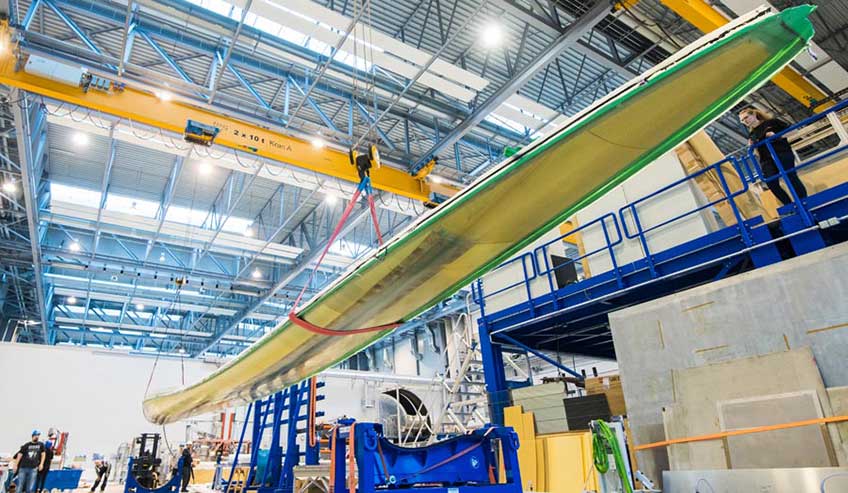National Wind Technology Center to Help Verify Bend-Twist Coupled Smart Blades

One of DLR’s smart rotor blades. Photo courtesy of DLR
The National Renewable Energy Laboratory (NREL) has embarked on an 18-month agreement with German research institution Deutsches Zentrum für Luft- und Raumfahrt (DLR), which translates to German Aerospace Center, to collaborate with the German cooperative research project “SmartBlades2” by evaluating the consortium’s pioneering rotor concept at the National Wind Technology Center (NWTC).
Funded by the German Federal Ministry for Economic Affairs and Energy, one of the goals of SmartBlades2 is to prove the feasibility and efficiency of the smart blades rotor product—a unique rotor that utilizes passive controls in the form of blade bend-twist coupling. This means that the blade simultaneously bends in the direction of the oncoming wind and twists in the blade's pitch axis direction to shed loads experienced during turbulent wind conditions. If found to be economically feasible, this innovative design could greatly reduce materials and blade costs and positively impact wind turbine levelized cost of energy.
Validating the designs in real-world conditions is a critical step toward verifying their intended performance and load-reduction capability.
“Field validation of the SmartBlades2 rotor gives us the opportunity to measure the behavior of the rotor and later characterize the load reduction benefits by comparing the measured data with the developed models. In this way, the aerodynamic performance of the blades can be assessed under different wind inflow conditions,” said NREL Engineer Andy Scholbrock. “This in turn will demonstrate a proof-of-concept of the technology and improve future wind turbine modeling efforts.”
NWTC experts will conduct field characterization of the rotor concept using the site’s three-bladed Controls Advanced Research Turbine (CART3) to measure blade loads, blade tip displacement, and blade torsional response, which will aid in verifying the project’s design goals. The German consortium partners will then compare the data against simulation results produced in their model validation effort.
Last month at the NWTC, Scholbrock, along with Lee Jay Fingersh, Anne Miller, Sam Rooney, Brian Smith, and Alan Wright—all of whom worked to secure the agreement—met with the German counterparts to kick off the partnership.
“Luckily, we had great documentation on the CART3 wind turbine, which helped us work out all the intricate details during numerous early morning phone calls with DLR and their partners for how this project will take place,” Scholbrock said. “Additionally, the many years of experience that Garth Johnson and Scott Wilde have had with this wind turbine since its origin in Hawaii will be invaluable for us throughout this project for installing and instrumenting the SmartBlades2 rotor.”
The German research consortium consists of DLR, the Fraunhofer Institute for Wind Energy Systems, ForWind (comprising the universities of Hanover and Oldenburg), GE Global Research, Henkel AG & Co. KGaA, Nordex Energy, Senvion, SSB Wind Systems GmbH & Co. KG, and Suzlon Energy Ltd. und WRD Wobben Research and Development GmbH.
Installation is scheduled for summer 2018, and validation will occur during the 2018‒2019 wind season, which occurs over the winter.

